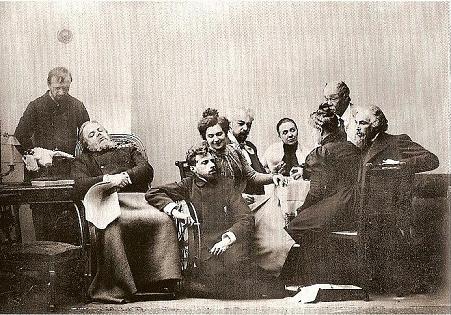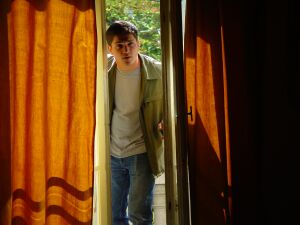La Mouette
(1896)
d'Anton P. Tchekhov (1860-1904)
De La Mouette il écrit à l'un de ses amis avant la création de Saint-Pétersbourg : « J'écris une pièce étrange. Je l'écris sans plaisir véritable, même si j'y viole toutes les conventions de la scène. Il n'y a que des conversations à propos de littérature, aucune action et cinq pouds d'amour ! »
After making a lot of promises that he would never deal with theatre again, after a good many one-act plays performed all over Russia, Chekhov started to write a new drama on the 21st of October, 1895. "I am writing with pleasure, although I offend against the laws of theatre. Comedy, three female and six male roles, four acts, a landscape (a panorama of the lake), many discussions about literature, little action, five pounds of love." On the 18th of November he wrote: "I finished the play. I started forte and finished pianissimo, breaking all the rules of theatre art. It turned to be a short novel.
(...) Chekhov read the play in front of a wide company, this was the first audience of the Seagull, and the theatre critics mainly used to the overwhelming plots of Sardou and Dumas generally didn't like it. The first objection was that Potapenko the seducer of Lika was easily discernible in the figure of the famous writer, Trigorin. (Chekhov has condensed many autobiographical elements in this character, too, but the critics didn't notice it at the beginning.)
The censorship was studying deeply and for a long time the text of the Seagull. The main condition was that the young heroine should not notice the affair of her mother and Trigorin. They had a detailed correspondence about this problem, dealing with even the deleting or substitution of certain conjunctions. Chekhov lost his polite patience to the end of the summer and instead of detailed texts he started giving short instructions to Potapenko who was discussing with the censors in the name of Chekhov. Furthermore - that has never happened before to the author scrupulously correcting even the fifth edition of his own works - he wrote to Potapenko: "You can substitute the sentences 'I cannot make out what she is up to. She simply doesn't speak.' with 'You know, I don't like her' or whatever you want, you can even quote from the Talmud. Or just insert something like that : 'Oh, in her age ! Oh, oh, isn't she ashamed ! "
1896 - the premiere of the Seagull in the Alexandrinsky Theatre, Saint Petersburg.
There were only a few rehearsals before the performance. Nobody understood the play except Comissarjevskaya, one of the most prominent personalities of Russian theatrical art, who played Nina, and received the text four days (!) before the premiere. The actors haven't memorised their roles...
On the evening of 17th October 1896, before the premiere, the chaos reached the summit. Everybody was perplexed, the general atmosphere was anything, but not cheerful. The audience (attracted to theatre by the bonus play of Saint Petersburg's favourite comedienne) was waiting patiently at the beginning. But when the famous monologue of the insert play has started : "Men, lions, eagles and doves, red deer, geese, spiders, and you, mute fish living in the water" - the enthusiastic words of Comissarjevskaya were interrupted by some silly guffaw. As if given the cue, the entire audience started to whistle, laugh, hiss and beat with the feet.
The voice of the actress was hardly even heard in the general pandemonium... The performance turned out to be a scandal; even experienced old men of literature as Suvorin agreed in never ever having seen such a horror.
The author has disappeared in the meantime. After the performance they were desperately looking for him, but he was nowhere. He left with the first freight car to Melihovo. When his sister arrived home, instead of greeting her, he said her not even mention the play. His diary has preserved only a few sentences with the date of 17th October : My play, the Seagull was presented today at the Alexandrinsky Theatre. It was not successful. (...) The critics never spoiled Chekhov. Still, what he had to bear at 17th October and the days after was incomparable to everything before. Here is one typical example out of the many, written by an otherwise important literary critic : "I don't know, I don't remember when Mr. Chekhov turned to be a great talent, but for me it is undoubtedly true that it was a mistake to raise him to this literary rank... His play entitled Seagull gives first of all the impression of a writer's awkwardness, of the literary inertia of a frog blowing up itself. One feels that the author is willing to say something - what exactly, he himself doesn't know - but is incapable of reaching his goal. And all the efforts, all the strains of this tiny little art seem to be pathologically piteous..." Dozens of papers published critics written in this manner. (...) There was only one critic who was astonished by this attitude : "Whom and in what ways could Chekhov hurt, whom could he insult, who is he hindering to deserve this malevolence? Is it possible that skills and popularity are sufficient reasons to evoke it ?"
The second performance - the improved variant of the play, presented for a different audience, with roles that finally were memorised - was met with the well-deserved success. Comissarjevskaya could send the happy telegram in the first minutes after the performance : "Anton Pavlovich, my darling, we won !" The success came too late, this time the performance attracted no attention, and the play was removed from the agenda after the fifth show.
Chekhov wrote in December to Suvorin : "Lately I have calmed down, my mood is just the usual, but I cannot forget what happened - as I couldn't have forgotten a slap for example..."
Ágnes Gereben : Csehov világa (The world of Chekhov)
Európa Publishing House, Budapest, 1980.
Mizinova to Chekhov, Pochrovskoye, 1st November 1896.
(...) It is scandalous that you write three line-letters - this is egoism and disgusting laziness ! As if you didn't know that I am collecting your letters in order to sell them later and thus assure a living for my old days !
Let me know when you arrive to Moscow. We need to discuss a particular problem; I won't keep you long. Don't fear to stay at my place. I will not allow myself any indecency, if only because I'm afraid to ascertain about happiness never coming. Thus I will have at least a little hope left. Good bye. (Ar.)* too times rejected by you, that is L. Mizinova
See, now you have a pretext to call me liar !
Here everybody says that you have borrowed the Seagull from my life, and they also say that you're upbraiding someone else here, too !
*Ariadna, see Chekhov's short story with the same title Csehov szerelmei (Chekhov's loves), ed. by Annamária Radnai, Magvető Publishing House, Budapest, 2002.
"The Seagull is a big rubbish, it does not worth anything ; it is written as if Ibsen wrote it." - Tolstoy. Note in Suvorin's diary, 11th February, 1897.
L’ensemble du Théâtre d'Art est aux champs depuis le début de l'été. Stanislavski commence à répéter La Mouette en août 1898, à Pouchkino, la propriété d'un ami, à trente verstes (1 verste = 1067 mètres) de Moscou non loin de Lioubimovka, sa maison de campagne. Tous les jours, il fait le chemin à cheval pour s'y rendre.
Most of the critics considered that the play has failed because it was a weak drama. It is impossible to find out from contemporary critics what the real reason of the failure was, the single document that can offer some clues is the director Evtihy Karpov’s much later found notebook. It seems that he has misunderstood the play.
According to his notes, Karpov’s interpretation - and thus also his presentation - was focussing onto the melodrama of Nina Zarechnaya. It states that "The heart-broken Nina stands lonely and she is proudly facing all the other characters, these egoistic, petty-minded people." (Role-interpretation is a question to doubt, knowing that the actress has received Nina’s role four days before the performance.)
Two years later Nemirovich-Danchenko fell in love with the play and persuaded Stanislavsky to make the performance. At that moment Stanislavsky neither has liked, nor has understood the play. It was summer, he withdrew to his brother’s estate and wrote the director’s text variant of the Seagull, thus performing the reform of Russian theatre. He started to love and understand the play while writing about it.
Un ensemble tout frais, constitué par la fusion des deux groupes, celui de Stanislavski - le Cercle d'Art et de Littérature - et celui de Nemirovitch - ses élèves de la section dramatique de la Société Philharmonique. Ils sont partis à la campagne pour y préparer la saison car les salles de répétitions sont trop chères à Moscou, mais surtout pour se découvrir, se connaître mieux, mettre en pratique les principes de la vie communautaire et les règles éthiques sur lesquels les deux pères fondateurs entendaient développer leur projet théâtral.
Une pièce qui tourne résolument le dos au naturalisme, une pièce dans laquelle l'auteur tout comme le metteur en scène ont tenté de saisir l'ineffable. Une pièce qui selon les critères de l'époque, n'en est pas une vraiment. Le sujet en lui-même frise la banalité.
L'histoire : Un été à la campagne : Treplev, un jeune homme révolté contre la routine dans l'art et aspirant à inventer de nouvelles formes d'écriture dramatique, aime Nina, qui elle, rêve de devenir une actrice adulée comme Arkadina, la mère de Treplev. Dédaignant l'amour sincère de Treplev, Nina est amoureuse de Trigorine, écrivain célèbre dans les salons de la capitale et amant d'Arkadina. C'est en somme le conflit de deux mondes, du factice et de l'authentique, de l'amour vrai et de l'amour-illusion, de la recherche artistique véritable contre l'arrivisme, de la vérité et du mensonge. Ne supportant plus ni ces contradictions, ni d'être rejeté à la fois par les deux femmes qu'il aime, sa mère et Nina, Treplev se suicide. Trigorine reverra secrètement Nina à Moscou ...
The director’s text variant was first published in 1938, forty years after the premiere (later on, in 1981, it was re-published in six volumes, together with other director’s text variants). In the introduction Stanislavsky considered it important to distance himself in a certain degree from his own earlier work, as his ideas have changed a lot in the meantime. This was the method of a despot, with whom he was on bad terms at the moment, as he stated; however, three decades after the Seagull he wrote in the same manner the director’s variant for Othello (this was published in 1945). For his excuse it should be mentioned that Stanislavsky was cured in Nizza and he directed the rehearsals from there, that’s why such a precise director’s variant was needed.
Stanislavsky called the carefully written director’s text variant a score, the visible and audible music of the play. Everything happening on stage was in there. However, one thing was missing, it could not have been integrated : if the performance played according to these instructions was going to be successful. It was successful. Stanislavsky was not proclaiming the ideas of a new theatre creation at the time of "writing" the Seagull, he was not predicting the reforms yet, but he made it, wrote it, directed it (and also played it). The innovations could really be noticed in this copy. The date of the premiere was 17th December 1898.
A part of the innovations have become routines since then, they have been used up. The instructions for the scenery, sounds, noises, movements and actors demonstrate the idea that this theatre should be based on being and life, not on a playing-game. It is the creation of a second realism. It is realism itself. Since then this realism stays in theatre as some kind of illness (or virtue ?). (...)
en 1898, La Mouette, m.s. Stanislavski & Nemirovich-Dantchenko
One focus point of Stanislavsky’s reform was the space, the scenery, and the stage-picture. He wanted to liquidate the empty stage, the proscenium. He wanted to create a life-like space (see : a second reality), which was packed, with a lot of things in a disorder, both in the first two acts (happening "outdoors") and the last two ("the house"). (...) Stanislavsky built up consequently and in an ostentatious manner a fourth wall out of mainly those things that were in the foreground of the stage. He sat his actors onto a long bench as a fourth wall, facing with the back the audience. That’s how they were watching Trepliov’s play. (Stanislavsky succeeded in building this fourth wall so dominantly that since then everybody constantly wants to demolish it, together with the other three.) (...)
Olga Leonardovna Knipper (who became Chekhov’s wife in 1901) played the role of Arkadina. She wrote that the Seagull’s important factors were was neither the scenery, nor the costumes, but only the actors. Meierhold played Trepliov. Later on, when Meierhold left the Art Theatre (and he became an opponent of it), he wrote that the success of the Seagull was due to the actors’ performance, not to the direction of Stanislavsky. Knipper and Meierhold played very well. Chekhov also liked them.
Chekhov wanted to take the role of Nina from Roxanova. The actress has left the theatre soon. Masha, performed by Maria Lilina (Stanislavsky’s later wife), was much better than she was. All the critics considered it important to mention Masha.
According to the critics the other weak interpretation of the play was Trigorin, performed by Stanislavsky. Not the director, but the actor was unsatisfying. (...) Chekhov has altered in the greatest degree Medvedienko’s role. He was very much afraid of Medvedienko’s character; he deleted all the earlier texts, until in the last variant Medvedienko was almost not talking at all (but he was present). Chekhov must have feared that this Medvedienko constantly talking about money can easily slide into a caricature-figure. (...) "What kind of person is this writer ?" - Sorin raised the question in Act I. What kind of person was Trigorin, then ? Stanislavsky was not a good Trigorin. Chekhov didn’t like it himself. His figure was built on one single feature : weakness. He was a weakling, an extremely complacent Trigorin - wrote Ephros about him. Stanislavsky played the role of Trigorin for seven years; he transformed the role in 1905.
Andrea Tompa : Száz éve és ma (A hundred years ago and today). Színház, 2002/2
Une intrigue bien mince pour un enjeu aussi vital. On fait le forcing sur le nombre de répétitions. Nuits blanches et crises de nerfs. Conflits entre directeurs, conflits entre directeurs et bailleurs de fond. Le soir de la première, peu avant que le rideau ne se lève, les acteurs avalent des dragées de Valériane pour se tranquilliser...
La dernière réplique de La Mouette tombe dans un silence de mort. Le public est étourdi et encore sous l'emprise de la fascination. Suspendus à ce moment de silence qui semble une éternité, les acteurs tétanisés d'angoisse n'osent venir saluer. Une actrice s'évanouit en coulisse, Stanislavski est au bord de la crise de nerfs. Et puis soudain, venu de loin comme un grondement tellurique qui monte de la salle, c'est l'explosion d'applaudissements. Ils se regardent, incrédules puis se jettent dans les bras les uns les autres, en sanglots. Les rideaux succèdent aux rideaux. Jamais le public de Moscou n'avait vu pareil spectacle. Plus jamais pour lui, le théâtre ne sera comme avant. Tous le savent, acteurs, public et presse. Le vingtième siècle théâtral est né.
Véra F. Komissarjerskaïa
1ère interprète de Nina en 1896.

Stanislavski dans le rôle de Trigorine.
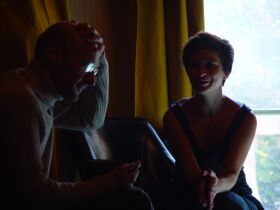
Nina (Annamaria Lang) & Trigorine (Tilo Werner)
m.s. Árpád Schilling (Krétakör, 2003)

Arkadina & Trigorine (Tilo Werner)
m.s. Árpád Schilling (Krétakör, 2003)
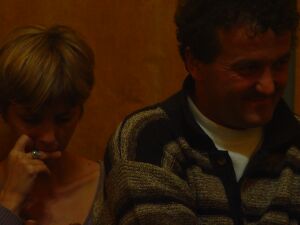
Paulina & Peter Scherer
m.s. Árpád Schilling (Krétakör, 2003)
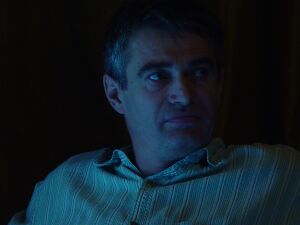
Dorn (Sandor Terhes)
m.s. Árpád Schilling (Krétakör, 2003)
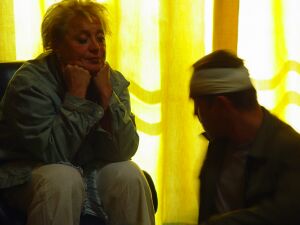
Arkadina & Treplev
m.s. Árpád Schilling (Krétakör, 2003)
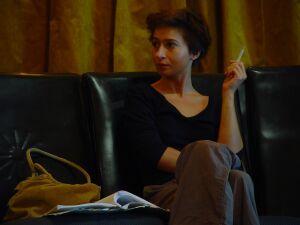
Nina (Annamaria Lang)
m.s. Árpád Schilling (Krétakör, 2003)
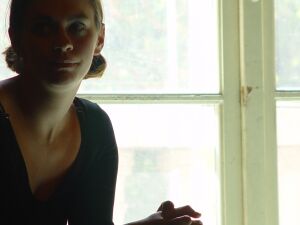
Masha
m.s. Árpád Schilling (Krétakör, 2003)
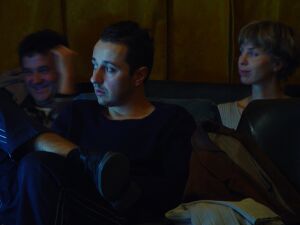
Medvedenko
m.s. Árpád Schilling (Krétakör, 2003)
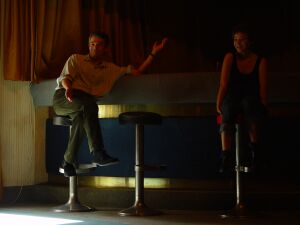
Dorn (Sandor Terhes) & Nina (Annamaria Lang)
m.s. Árpád Schilling (Krétakör, 2003)
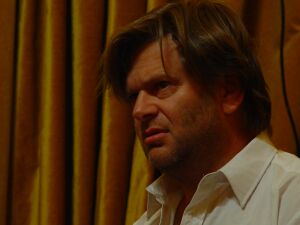
Sorin (Jozsef Gyabronka )
m.s. Árpád Schilling (Krétakör, 2003)

Trigorine (Tilo Werner) & Nina (Annamaria Lang)
m.s. Árpád Schilling (Krétakör, 2003)
.jpg)
